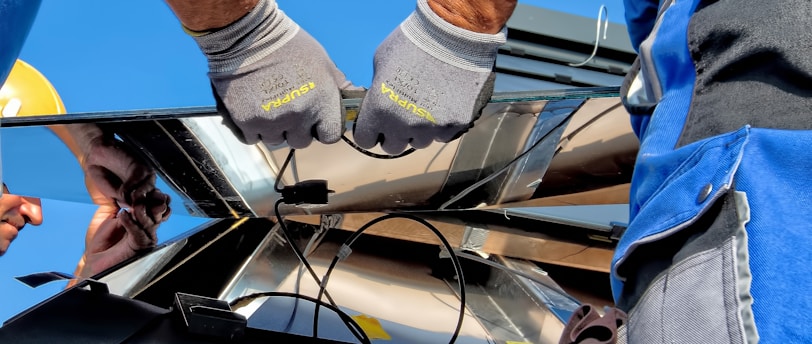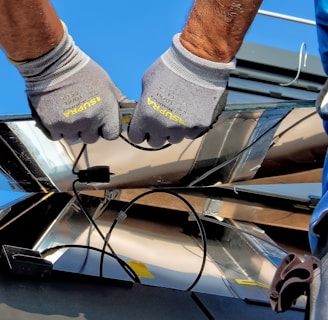Solar Energy Kits Guide
Explore the world of solar energy with our definitive guide on solar energy kits. Learn how to choose, install, and maintain your kit for sustainable power generation at home.
SOL GUIDE
8 min read


This guide focuses on the essentials of solar energy kits, including the selection of the right components, the installation process, and the importance of regular maintenance for optimal performance.
"Solar energy can be seamlessly integrated into your home, offering both environmental and economic benefits."
Solar Energy Kits: A Gateway to Renewable Power
Solar energy kits represent a significant step towards achieving energy independence and reducing carbon emissions. These kits provide a one-stop solution for homeowners looking to harness the power of the sun, offering a straightforward way to generate clean energy. They cater to a variety of applications, from small-scale residential setups to more extensive off-grid living, making renewable energy more accessible than ever.
The allure of solar energy kits lies in their simplicity and the empowerment they offer to individuals. By combining solar panels, inverters, batteries, and management systems in a single package, these kits demystify the process of transitioning to solar power. This introduction lays the groundwork for understanding how solar energy can be seamlessly integrated into your home, offering both environmental and economic benefits.
At the core of solar energy kits are photovoltaic (PV) panels, which capture sunlight and convert it into electricity. These panels are designed to be efficient and durable, capable of generating power for decades. The technology behind PV panels has evolved significantly, allowing for higher energy conversion rates and making solar energy more viable for a wide range of climates and locations.
Understanding the components and functionality of solar energy kits is essential for anyone considering making the switch to solar. This knowledge not only aids in selecting the right kit for your specific needs but also in appreciating the sophisticated technology that enables clean, renewable energy production at home.
Selecting the right solar energy kit requires careful consideration of your energy needs, available space, and budget. Key factors include the kit's power output, compatibility with existing electrical systems, and ease of expansion to meet future energy demands.
We Recommend This Waterproof Lawn Solar Lighting
The installation of solar energy kits requires precise steps and considerations to ensure optimal performance and safety. Here’s a more detailed and helpful approach:
Site Assessment and Planning: Before installation, assess the site for solar potential. This involves analyzing the direction and angle of sunlight exposure, shading from trees or structures, and the roof's condition if mounting panels there. Use tools like solar pathfinders or software to map the sun's trajectory across your property. This step is crucial for determining the best location for your panels to maximize sunlight exposure throughout the year.
Mounting System Installation: Choose a mounting system that suits your installation site, whether it’s a rooftop, ground mount, or pole mount. Ensure that the mounting structure is robust enough to withstand environmental stresses like wind and snow loads. For rooftop installations, verify the roof’s structural integrity and use waterproof sealants to prevent leaks around mounting brackets.
Panel and System Configuration: Decide on the configuration of your solar panels. Panels can be set up in series to increase voltage or in parallel to increase current, depending on your system's requirements. This step directly impacts the efficiency and compatibility of your solar kit with the inverter and battery storage system.
Electrical Wiring: Proper electrical wiring is essential for the safety and efficiency of your solar energy kit. Use the appropriate gauge of wiring to handle the system's power output and minimize losses. Install safety devices such as circuit breakers and ground fault protectors to protect against electrical hazards. All wiring should comply with the National Electrical Code (NEC) and local regulations.
Inverter Installation: The inverter, which converts DC electricity generated by the solar panels into AC electricity usable by home appliances, should be installed in a location that protects it from the elements while ensuring adequate ventilation. The inverter’s capacity should match or exceed the total wattage of your solar panels.
Connection to the Power Grid or Battery Storage: If your system is grid-tied, you’ll need to connect it to the power grid, which usually requires a professional electrician and adherence to utility company guidelines. For off-grid systems, connect your solar panels to battery storage, ensuring the batteries are sized appropriately for your energy needs and are properly ventilated.
System Testing and Commissioning: Once installed, thoroughly test the system to ensure it operates correctly. This includes verifying that all connections are secure, the system is grounded properly, and the inverter is correctly converting power. Monitoring equipment should be set up to track the system's performance over time.
Obtaining Permits and Inspections: Before and after installation, ensure all necessary permits are obtained, and the system is inspected by local authorities to certify its compliance with local building and electrical codes. This step is critical for legal compliance and safety.
To ensure your solar energy kit operates efficiently and safely over its lifespan, here are more detailed guidelines for consulting with professionals, adhering to manufacturer instructions, and performing regular maintenance:
1. Consulting with a Certified Solar Installer:
Initial Consultation: Begin by scheduling a consultation with a certified solar installer who has a proven track record and relevant certifications (such as NABCEP in the U.S.). This professional can provide a detailed assessment of your property, taking into account factors like roof strength, orientation, shading, and local climate conditions, which are crucial for optimizing the system design.
Custom System Design: The installer will design a solar energy system tailored to your specific needs, considering your energy consumption patterns, future energy goals, and budget. This design process includes selecting the appropriate size and type of solar panels, inverters, and battery storage (if needed) to maximize energy production and efficiency.
Permitting and Interconnection: A certified installer can also navigate the complex permitting process and utility interconnection requirements on your behalf. They understand local regulations and codes, ensuring your system complies with all legal standards and is eligible for any available incentives or rebates.
2. Following Manufacturer Instructions:
Installation Compliance: Carefully follow the manufacturer's instructions for each component of the solar energy kit during installation. This includes specific guidelines for mounting hardware, electrical connections, and system configuration to ensure optimal performance and prevent damage.
Warranty Preservation: Adhering to the manufacturer's guidelines is essential for maintaining the validity of warranties. Many manufacturers require installation by certified professionals and may specify maintenance routines. Failure to comply with these instructions could void warranties, leaving you responsible for the cost of repairs or replacements.
Safety Standards: Manufacturer instructions also include safety standards for installation and operation. These standards are designed to protect you, your property, and the installation team from electrical hazards, structural damage, or fire risks.
3. Performing Regular Maintenance Checks:
Routine Inspections: Conduct regular inspections of your solar panel system to identify and address potential issues such as dirt accumulation on panels, wear and tear on mounting systems, and corrosion on electrical connections. Inspections should be more frequent in harsh weather conditions.
Cleaning Panels: Solar panels should be cleaned periodically to remove dust, bird droppings, leaves, and other debris that can reduce efficiency. Follow the manufacturer's recommendations for cleaning methods and frequency to avoid damage.
System Monitoring: Install a monitoring system to track your solar energy production, consumption patterns, and system health in real-time. Monitoring can help quickly identify underperformance or malfunctions, allowing for prompt corrective actions.
Professional Maintenance: Schedule annual or bi-annual maintenance checks with a certified solar technician. These checks can include in-depth inspections of the electrical system, testing of the inverter and batteries, and ensuring that the system is performing according to its specifications.
Ensuring Successful Installation of a Solar Energy Kit
Installation List and Considerations
Selection Criteria
Solar Energy Kits: A Gateway to Renewable Power


Solar Energy Kits on Amazon
Solar Kits Off Grid
Off-grid solar kits are designed for locations that lack access to the main electricity grid, providing a self-sufficient solution for generating power. These kits typically include solar panels, a charge controller, battery storage, and an inverter, enabling users to capture, store, and convert solar energy into usable electricity. Ideal for remote homes, cabins, or any off-the-grid applications, these kits are engineered to meet all the energy needs of a household or operation independently. Off-grid solar kits are not only about sustainability but also about resilience, offering a reliable power source in areas where traditional power is unavailable, unreliable, or too expensive to install.
The selection of an off-grid solar kit requires careful consideration of your energy consumption, as the system needs to be sized appropriately to handle your load requirements and ensure enough power during periods of low sunlight. The battery storage component is particularly crucial, as it must be capable of storing sufficient energy to power your home or application through the night and cloudy days. Moreover, off-grid systems often incorporate additional features such as backup generators or wind turbines to provide power during prolonged periods of insufficient sunlight, ensuring a continuous power supply.
Investing in an off-grid solar kit represents a significant upfront cost but can result in substantial long-term savings and independence from utility companies. It's a proactive step towards a sustainable lifestyle, reducing one's carbon footprint and participating in the global shift towards renewable energy sources. Proper planning, installation, and maintenance are key to maximizing the efficiency and lifespan of an off-grid solar system, making it a viable and rewarding energy solution for those willing to embrace the off-grid lifestyle.


For our Artice on Using or Getting a Solar Generator
If Interested in Maximizing Solar Electric Efficiency
Solar Kits DIY
DIY solar kits have emerged as a popular option for homeowners and hobbyists looking to harness solar energy without the significant expense of professional installation. These kits typically come with all the necessary components, including solar panels, inverters, mounting equipment, and detailed instructions, allowing individuals to install their solar energy system with minimal technical expertise. DIY solar kits cater to a range of applications, from small, portable setups for RVs and camping to larger systems designed for residential power supply. The appeal of DIY solar kits lies in their cost-effectiveness and the satisfaction of personally contributing to one's energy independence and environmental sustainability.
Embarking on a DIY solar project requires a willingness to learn and a careful assessment of one's energy needs and installation capabilities. While DIY kits make solar accessible, they also demand a cautious approach to ensure safety and compliance with local codes and regulations. Homeowners must understand the basics of electrical systems and solar technology, as well as the importance of proper placement and orientation of solar panels to maximize energy production. With the growing availability of resources and communities dedicated to DIY solar energy, individuals are empowered to take control of their energy future, reduce costs, and gain a deeper understanding of renewable energy systems.


We Recommend These Lawn and Sidewalk Solar Lights for Night Visibility
To support our work, we may earn a commission when you buy through links on our site. As an Amazon Associate, I earn from qualifying purchases.
Cookie Notice: Our website uses cookies to enhance your browsing experience. By continuing to use our site, you agree to our use of cookies. If you wish to manage your cookie preferences, you may do so in your browser settings.
To support our work, we may earn a commission when you buy through links on our site. As an Amazon Associate, I earn from qualifying purchases.This page may contain affiliate links, which means if you click through and make a purchase, we may receive a commission at no additional cost to you. This helps support our research and editorial team.




